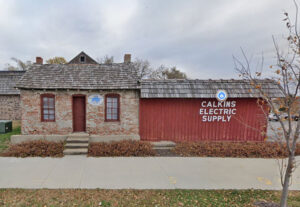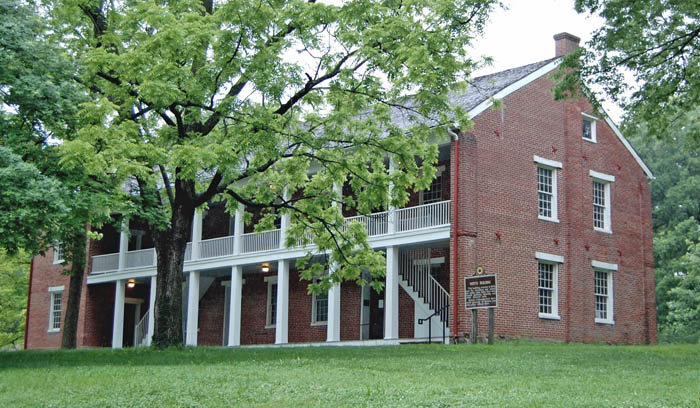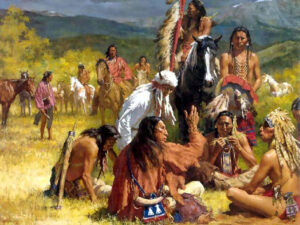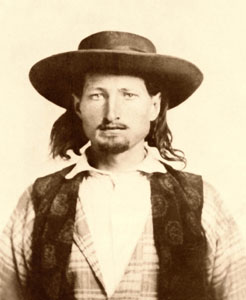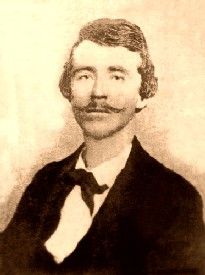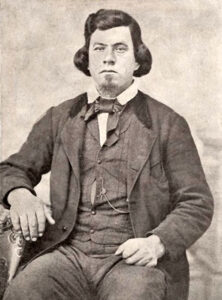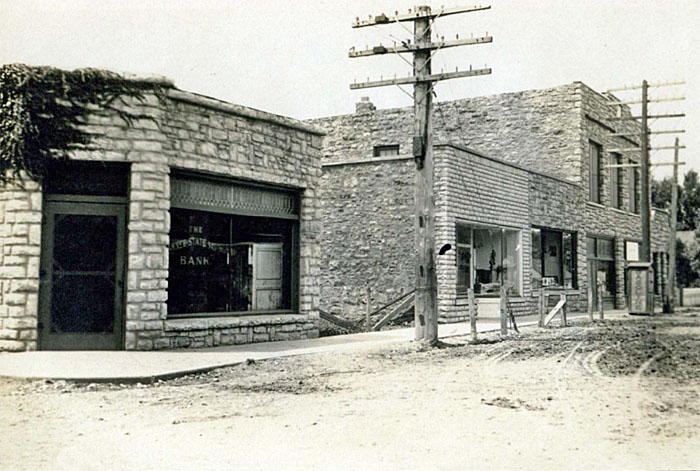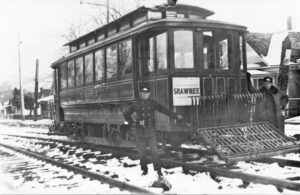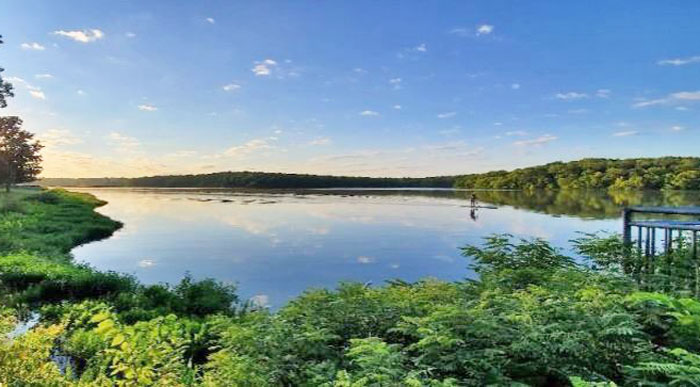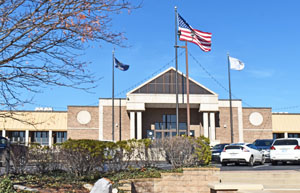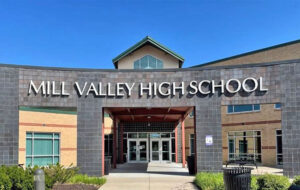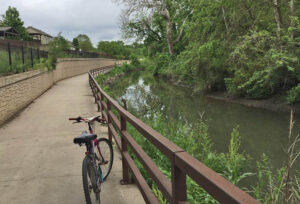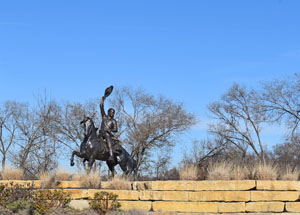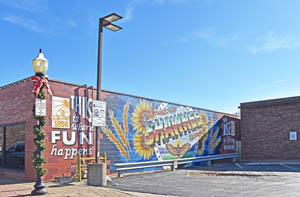Shawnee, Kansas, in northern Johnson County, is the seventh-most populous municipality in the Kansas City metropolitan area. As of the 2020 census, the population of the city was 67,311.
Shawnee’s heritage reaches back to the era of Osage Indian dominance. Captain M. Etienne Veniard DeBoursement, a French explorer, discovered a Kansas Indian Village near present-day Shawnee in 1724.
The first white hunter known to enter this area was Jacob “Joe” Pursely in 1802. In 1815, Francis Chouteau established a trading post near the current site of Kansas City, Kansas, and in the 1820s, the Chouteau brothers established several trading posts along the Kansas River.
In 1823-24, Chris Fangro erected a building that later served as the Wells Fargo stage station on the government trail from Fort Leavenworth to Fort Scott and Fort Gibson, Oklahoma. Part of the building remains today as the front of the Calkins Electric building at 5707 Nieman Road in Shawnee.
In 1825, the Shawnee Indian treaties were signed, removing the Shawnee from Ohio, Pennsylvania, Indiana, and Missouri to Kansas. Johnson County became their headquarters, although the Shawnee Reservation extended westward to Topeka. Over the next ten years, Shawnee people from different parts of the country were moved to the reservation. The treaties gave 1,600,000 acres of land in Johnson, Wyandotte, and Douglas Counties areas to the Shawnee Indians. Overall, 1,600 Shawnee were relocated to Kansas from Missouri, eastern Ohio, Indiana, and Western Pennsylvania, originally occupying Georgia and later Tennessee.
The United States government also signed a treaty with the Osage Indians in 1825, giving the U.S. right-of-way for a public highway known as the Santa Fe Trail.
In 1828, the first band of Shawnee arrived in Kansas after wintering at Cape Girardeau, Missouri. They decided on the area of present-day Shawnee as their headquarters, although their territory included all lands from the Missouri border to present-day Topeka.
Farming began in the area in the 1830s, and the first wheat was grown in Kansas.
Reverend Thomas Johnson established the Shawnee Methodist Mission and Manual Labor School in Turner, Wyandotte County, in 1830. That year, a log council house was constructed on a farm now part of McAnany Estates, near 53rd and Nieman Road. A smallpox epidemic also erupted, killing most of the Shawnee Tribe and members of other tribes who had arrived, including the Kickapoo, Delaware, Munsee, and Wyandot.
In 1832, the remainder of the Shawnee tribes arrived from Ohio, and the population of the Shawnee was about 1,000. On July 11, 1832, Alexander S. Johnson was born at the Methodist Mission, the first white child born in Kansas Territory. He would later be one of Shawnee’s city founders.
That year, what was then called Gum Springs had two dry goods stores, a grocery store, a blacksmith, a harness shop, a hotel, other places of business, and about 400 residents.
1833, Jotham Meeker arrived in Westport, Missouri, from Michigan and brought the first printing press to Kansas. Two years later, Meeker started the first newspaper in Kansas, the Shawnee Sun, which was also the first in the Shawnee language.
In 1838, a Military Road was built from Fort Leavenworth, Kansas, to Fort Gibson, Oklahoma. Later, Shawnee was on both the Ft. Leavenworth-Ft. Scott Military Road, which tied it into the government-organized transportation routes that connected installations before and after the Civil War. Shawnee was also on a government road that connected Fort Leavenworth to Fort Riley.
In 1839, Reverend Thomas Johnson moved the Shawnee Methodist Mission to its current location, at 3403 West 53rd Street, in present-day Fairway, Kansas. The Methodist Mission contained 2,000 acres and 16 buildings, including mills, shops, and factories where several thousand Indians were taught agriculture, manual trades, and domestic arts until 1862. The site is a museum today.
In 1840, the Santa Fe Trail was established between Independence, Missouri, and Santa Fe, New Mexico, passing through Overland Park, Lenexa, and Olathe. Before long, 600 wagon trains per week passed through Johnson County on their way to Mexico.
Shawnee was the first community founded in Johnson County and was originally a campsite called Gum Springs.
In 1844, devastating flooding of the Kansas River destroyed the mills and farmlands of the Shawnee Indians.
During the 1840s and 1850s, branches of the Oregon, California, and Santa Fe Trails wound through part of Shawnee’s current eastern area.
In 1853, the First Kansas Territorial election was held, with half the votes cast in Gum Springs.
In May 1854, a new treaty with the Shawnee Indians was signed, in which the Shawnee surrendered 1,600,000 acres in exchange for $829,000 (less than $1.00/acre) and 200,000 acres to be distributed in individual allotments. It allowed the Shawnee to stay in Kansas, taking 200 acres or land allotments in Oklahoma. Some stayed while many left. On May 30, 1854, the Kansas-Nebraska Act was passed and signed by President Franklin Pierce. Kansas became a territory that extended into eastern Colorado, opened for white settlement, and Gum Springs grew rapidly. From November 24, 1854, to June 27, 1855, and from July 1855 to the Spring of 1856, the Shawnee Methodist Mission served as the capital of Kansas Territory.
The area was platted in 1856, and the Shawnee Methodist Mission served as Johnson County’s first county seat. Shawneetown was incorporated on August 10, 1856.
The oldest town in Johnson County, it got its start in 1857 when several families located near the old mission. A store was opened on August 10, 1857, which was followed by others, and great hopes were entertained for the settlement. The Methodist Episcopal Church South had erected a church during the mission days, but the first sermon preached for the benefit of the white settlers was in September 1857.
In 1857, Mr. J.D. Allen became the first white settler in the Shawnee area. Other early settlers were William Holmes, Richard Williams, J.T. Rowland, W. B. Maupin, and A.W. Wear. F. Conant opened a store on the south side of the public square on August 10, 1857. Gum Springs (later Shawnee) was designated the first county seat of Johnson County, and the first District Court was held here in the fall. A town was laid out that year, and J.D. Allen was appointed justice of the peace by the commissioners and held the position for many years.
The first school was taught in the spring of 1858 in an old Indian meeting house. The same year, W.B. Maupin built a steam saw and grist mill about 400 yards west of the public square. In July 1858, the first post office was established in Shawnee, with M. P. Randall as postmaster. The deed to Shawneetown is dated October 23, 1858, and the Territory began attracting many settlers. In 1858, among the first settlers was James Butler “Wild Bill” Hickok, elected Monticello Township constable at 18.
In 1859, the Shawnee Town Company began selling lots priced from $15 to $100, with those surrounding the public square commanding the highest prices. The same year, the fourth and last constitutional convention met at Wyandotte, Kansas, and drafted a document banning slavery and fixing the state’s present boundaries. The document was accepted by a vote of the people in October, and in December, a provisional state government was elected.
The town was officially incorporated in 1860, but the conflict between pro-slavery and Free State factions plagued the new town.
On January 29, 1861, the eastern portion of Kansas territory became the 34th state, and it joined as a free state after many years of turmoil. The many battles between Free-State advocates and pro-slavery men sparked the start of the Civil War. The declaration of a free state added to the tension between the anti-slave abolitionists and pro-slave Confederate guerrillas.
On October 17, 1862, Shawnee was raided by William Quantrill, a frustrated school teacher in his twenties, and his band of about 140 guerillas. They surrounded the town and corraled the residents in the square. Mr. Styles and Mr. Bicker were murdered in the streets, and all the stores in town were looted and the buildings set on fire. The Higgins Hotel, the largest house in town, was burned, as were 13 other buildings. Afterward, many settlers left the area to find safety elsewhere.
Quantrill and his army of bushwhackers returned in the summer of 1863 to raid and look for an escape route from Lawrence, which he intended to sack. The raids on Shawnee served as a training exercise before attempting the full-scale siege on Lawrence.
Quantrill selected Shawnee for its proximity to Lawrence, some 35 miles away. Lawrence was established for the political reason of being an anti-slave town and had many clashes with the pro-slavery advocates that started before the Civil War. The first documented event of Bleeding Kansas was the Wakarusa War, which saw both sides clash and come to a temporary truce. This allowed Lawrence to add to its defenses before the Sacking of Lawrence. In August 1863, the Lawrence Massacre took place at the hands of William Quantrill. This saw 250 men corralled and murdered and $2.2 million from damages.
In 1864, Charles Bluejacket was elected Shawnee chief. He was the grandson of Marmaduke Van Swerangen, a white man born in Virginia who had been captured by the Shawnee Indians and given the new name Bluejacket because he was wearing a blue hunting shirt at the time of his capture. Van Swerangen had been out hunting with a younger brother when he was captured by the Shawnee Indians and had agreed to go willingly to live with the Shawnee provided they released his brother.
Some Shawnee men served with Union forces at the Battle of Westport, Missouri, on October 23, 1864.
After the Civil War, Shawnee and the surrounding countryside settled down to peaceful farming. Many area farmers specialized in growing fruits and vegetables that were transported to market in Kansas City, Missouri, first by wagon and then by truck.
During the 1860s and 1870s, horse thieves were hung by a rope from a tall hickory tree in a little pioneer cemetery at 55th and Goddard, which came to be known as “Horse Thief Cemetery.”
The first schoolhouse was built in 1866 near the southwest corner of the public square.
In 1868, Shawnee’s St. Joseph’s Catholic Church was organized.
By 1875, most of the Shawnee Indians had moved to the Shawnee Reservation in Oklahoma, though some remained in the area.
In 1880, Shawnee had grown to a population of 2,600, from 500 in 1860.
Shawnee evolved into an agricultural service town of importance second only to Olathe in the late 19th century.
In 1910, Shawnee was one of the largest and oldest towns in Johnson County. It had a few general stores, a grocery store, a harness shop, a hotel, a blacksmith, a wagon shop, and a money-order post office and was the supply town for a rich farming district. An electric line furnished transportation facilities to Kansas City. The population in 1910 was 427.
Shawnee contained a more significant population before the Civil War than in 1915. At that time, the city was not incorporated and had no police force. However, it had one of the strongest and best-directed banks in the county, the Shawnee Savings Bank, incorporated in 1908 with a capital stock of $10,000 and a $5,000 surplus and deposits of $90,000. At that time, it also had three general merchandise stores, an exclusive dry goods store, a hardware store, and a nice school building with three rooms and an enrollment of 115. The Methodists had a strong organization under Reverend F.E. Modden and a membership of 105. Father T.P. Schwam is the head of the Catholic Church, which had a fine church with a strong membership.
Shawnee also had several businesses, including the J.H. Hurd general store; William Garrett & Son general store; Patti Brothers dry goods and notions; G. Geysels harness and hardware; W.H. Heaton, druggist; H. Caswell, barber; Mrs. E.L. Sautter, groceries; W.F. Blanton, machinery; B. Young, cafe and cold drinks; B.F. Hollenback, postmaster; Dr. W.O. Quiring, physician
By the 1920s, Shawnee’s truck farmers had helped the town gain a reputation as one of the region’s leading fruit and vegetable producers. Successful farming helped Shawnee’s farmers weather the Great Depression more successfully than in many other parts of the country.
By then, the school district offered both public and private schooling. Churches and social institutions, including the Grange, Masonic, Odd Fellows lodges and their auxiliaries, joined the citizens to accomplish goals that might prove impossible to achieve individually.
The city’s name was changed to Shawnee on June 10, 1922, when it was reincorporated as a city of the third class. It was named for the Shawnee Indians.
The volunteer fire department began to serve the safety and organizational needs of the community after the mid-1920s.
Spurred by the Hocker Interurban Line and Kansas State Highway 10 before World War II, Shawnee emerged in the last half of the 20th century as a comfortable, multi-faceted suburb providing good places to live and wonderful organizations to stimulate community life and involvement.
In the 1940s, during the post-war era, Johnson County began to develop with houses and highways.
Shawnee remained a stable farm center and small community well into the 1950s. The town accommodated the growth of local businesses and saw the arrival and demise of a trolley line and the growing use of automobiles. Street names and buildings have changed, but traces of the past remain.
While Shawnee developed its own suburbs in the form of Monrovia and Zarah at certain points in time. By the 1950s, it became clear that its future lay as a suburb in the larger Kansas City metropolitan area.
Shawnee was Incorporated as a city of the 2nd class on January 29, 1957.
On April 5, 1960, Shawnee passed a $65,000 bond issue to build its first City Hall in the city square, bounded by Johnson Drive, 58th St., Nieman Road, and Barton Avenue. Before this, offices had been at fire headquarters. Shawnee’s first City Hall was built that year.
Shawnee Mission Park, a multi-use, 1,600-acre park, was officially dedicated on May 30, 1964. With a 120-acre lake, it is the largest park in the county and the most visited park in Kansas. It is located at West 79th Street and Renner Road.
In 1966, the Shawnee Historical Society began the development of Old Shawnee Town to preserve local 19th-century buildings.
On October 29, 1967, the Johnson County Museum opened its doors. The new museum was located in the Greenwood School at 6305 Lackman Road.
In 1968, Shawnee annexed the area to Woodland Drive south of Johnson Drive. The city then covered 20 square miles, including the old townsite of Zarah.
In 1971, City Hall was remodeled, increasing in size from 6,000 square feet to 10,000 square feet. The same year, Shawnee annexed the area to K-7, south of 55th and north of 55th, between the railroad and Locust Street. These areas included the former towns of Monticello and Holliday. On October 22, 1971, Shawnee was incorporated as a first-class city.
In 1983, city sister programs were implemented in Listowel, Ireland, Pittem, Belgium, and Erfurt, Germany.
In 1984, Shawnee annexed land north of 55th, west of K-7. This included the Wilder townsite and the location of the Chouteau settlement.
In 1987, Shawnee annexed land south of 55th to 83rd/79th west to the Kansas River. The city’s size increased to 42 square miles, and ultimate boundaries were defined. This included the location of the settlement of Frisbie.
City Hall was remodeled in a $2.8 million expansion, tripling in size from 10,000 to 30,000 square feet in 1990. The dedication and open house were held on January 13, 1990, with Kansas Governor Mike Hayden participating in the ribbon-cutting ceremony. A time capsule was buried, including letters from local families to their children, Royals baseball cards, a bottle of homemade wine, a McDonald’s Happy Meal (minus the food), and many other items brought by local residents. Also buried in the vault was a two-hour documentary, “Shawnee, 1990,” which no one could view for 25 years until the vault was opened on January 17, 2015.
The Civic Centre at Johnson Drive and Pflumm was built in 1993. At the July 26, 1993, City Council meeting, the new parkland adjacent to Monticello Trails Middle School was named Gamblin Park. It was named in honor of Police Officer Donald B. Gamblin, Jr., who was killed in the line of duty on July 13, 1991.
In 1997, Shawnee was named Tree City USA.
Public Works Service Center, 18690 Johnson Drive, was completed in 1998. A dedication was held on March 28, 1998.
In 1998, a third fire station was added in western Shawnee to improve quicker response time.
The population was 50,000 in 2000.
Charles J. Stump Park was dedicated on March 24, 2001, and named after the first full-time police chief in Shawnee.
Mill Valley High School and Mize Elementary School were established.
In 2002, the West Pool underwent extensive renovation and was rededicated as the Thomas A. Soetaert Aquatic Center.
In 2003, the Charles Bluejacket Statue was dedicated; Garrett Park was completed with Parks and Pipes funds, and the Johnson County Landfill property was annexed. This included the last remaining portion of Monticello Township inside the City limits.
The city took over ownership and operation of Pleasant View Cemetery in 2004.
Monticello Springs Park was built with Parks and Pipes funds in 2005.
Shawnee celebrated its 150th birthday in 2006, and its Municipal Court received a 5-star rating in the Kansas City Star.
Splash Cove was dedicated in 2007, and that year, Shawnee was named one of the Country’s Top 25 Most Affordable Suburbs. The city also took over ownership and operation of Shawnee Cemetery.
In 2008, Shawnee was named one of two communities in Kansas and one of 89 communities in the United States to be designated as a Bicycle-Friendly Community by the American League of Bicyclists. Shawnee was one of Money Magazine’s Top 100 Places to Live the same year. The Justice Center and Fire Station 72 were dedicated, Water Tower Park was built with Parks and Pipes funds, and the city’s population was 60,000.
In 2009, Clear Creek Trail Phase I & II opened.
Groundbreaking began at Erfurt Park, and Clear Creek Trail Phase III was completed in 2013.
The city received the 2015 Secretary of Defense Employer Support Freedom Award for its efforts to support employees in the National Guard and Reserves.
In 2016, Old Shawnee Days celebrated its 50th anniversary.
Shawnee’s population peaked in 2020 at 67,311 and continues to grow.
In January 2023, Shawnee installed a 13-foot sculpture of Wild Bill Hickok on Shawnee Mission Parkway and Nieman Road. Depicting Hickok astride his legendary horse, Black Nell is meant to be a companion piece to a relief sculpture of a wagon train at Pioneer Crossing Park, 10406 Shawnee Mission Parkway. Hickok was a figure in Shawnee history in the 1850s when he began working with a wagonmaster. He gained his first law enforcement job as a constable for Monticello, which later merged with Lenexa and Shawnee.
According to the United States Census Bureau, the city has a total area of 42.86 square miles, of which 41.85 square miles is land and 1.01 square miles is water.
According to the town’s 2020 Comprehensive Annual Financial Report, the top employers in the city were:
FedEx Ground Package System, Inc., with 575 employees.
Bayer HealthCare, LLC-Animal Div with 550 employees.
First Student with 400 employees.
City of Shawnee with 330 employees.
Walmart Super Center with 300 employees.
Nazdar Industries with 280 employees.
Hy-Vee Food Stores with 250 employees.
KU MedWest with 225 employees.
Target Super Store with 190 employees.
Kraft Tool Company with 180 employees.
©Kathy Alexander/Legends of Kansas, updated February 2025.
Also See:
Monticello, Kansas – Merged with Shawnee
Wilder, Kansas – Extinct in Shawnee
Sources:
Blackmar, Frank W.; Kansas: A Cyclopedia of State History, Vol I; Standard Publishing Company, Chicago, IL 1912.
Blair, Ed; History of Johnson County, Stand Publishing Company, Lawrence, Kansas, 1915.
City of Shawnee
Cutler, William G; History of Kansas; A. T. Andreas, Chicago, IL, 1883.
Johnson County History
KCUR Radio
Shawnee Town
Wikipedia


